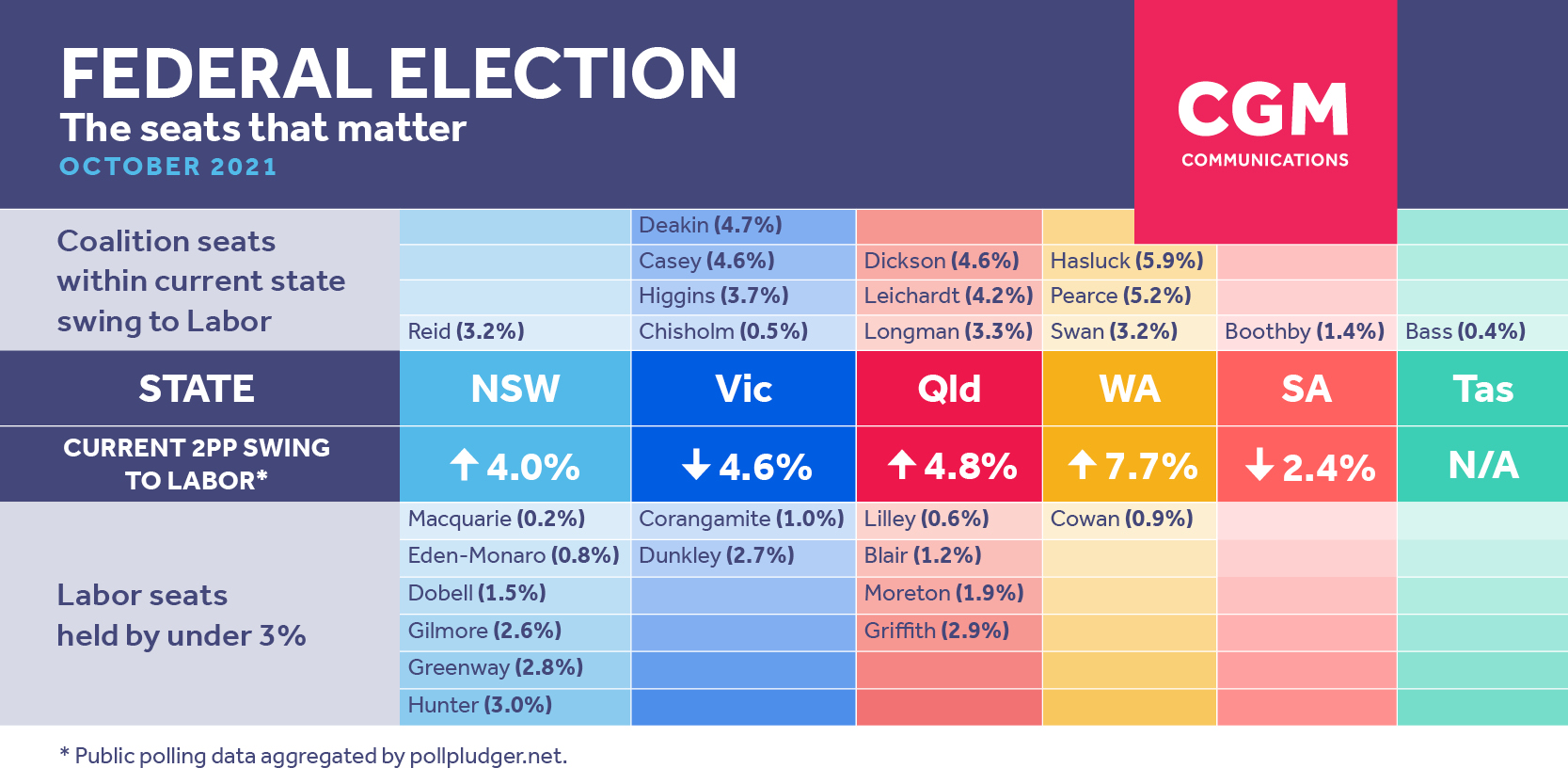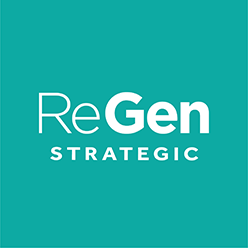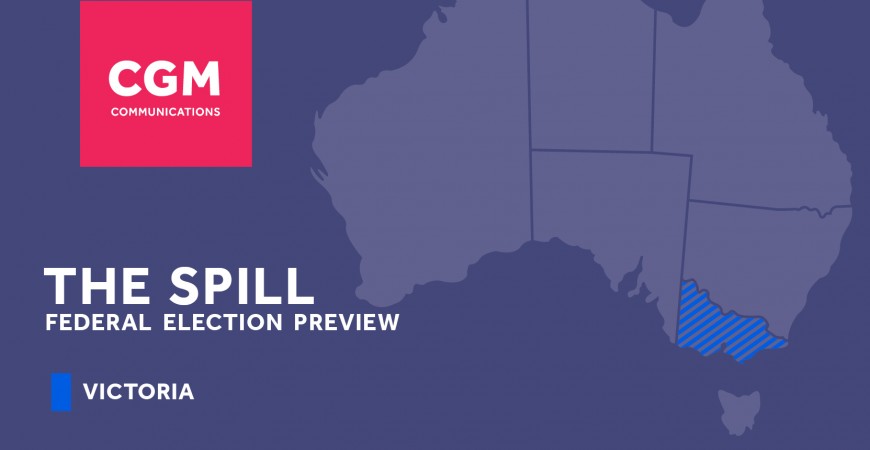After a momentous week in New South Wales politics, it would be tempting to re-visit the politics of that state, given its importance to the federal election outcome.
With new leaders for both the Liberals and Nationals, and outgoing premier Gladys Berejiklian now mooted for a run at federal politics, the landscape may have shifted. And there is still Ms Berejiklian’s appearance at ICAC to come. All as New South Wales reaches its vaccine targets and looks to open up, becoming the first state ‘living with COVID’.
We will come back to New South Wales later in the year, as polling becomes available that provides insights into the political impacts of current events.
This week, we update The Poll Bludger’s state-by-state model, following last week’s release of Newspoll data, and do a deep dive on the seats that matter in Victoria.
Updated Model

The updated model has the Morrison Government losing further ground in New South Wales, Queensland and Western Australia, but recovering some territory in Victoria and South Australia. There is still insufficient data to calculate a swing in Tasmania.
While there is still plenty of water to go under the bridge between now and the election, if the currently observed swings were replicated uniformly at the election, Labor would win 12 seats from the coalition and be elected to majority government.
Victoria
Labor currently holds 21 of the 38 federal seats in Victoria. Following the redistribution, it has become even more of a stronghold for Anthony Albanese, with the new seat of Hawke considered a sure thing for Labor.
Given this, if Victoria is to contribute to the seven seats Labor needs to win a majority government, Mr Albanese is going to have to win seats in what was once considered safe Liberal territory.
The swing of 4.6 per cent towards Labor currently being recorded by The Poll Bludger suggests this may be on the cards.
Like New South Wales, Victoria is at a critical point. Melbourne has now spent more time in COVID-lockdown than any city in the world. And, while one might expect this to play badly for the state Labor government, the fact that the current outbreak was seeded from a New South Wales outbreak that grew largely unchecked by the light-touch approach to COVID management of the Berejiklian government – an approach publicly backed by Prime Minister Scott Morrison – is not lost on many Victorians. A perception that vaccine supplies and financial assistance were prioritised for New South Wales, at the expense of Victoria, accentuates a feeling that Mr Morrison is a “Prime Minister for New South Wales” – a point Victorian Premier Daniel Andrews is not afraid to make.
On the topic of Premiers, something that has become clear since Ms Berejiklian announced her resignation on the weekend, is that it is very difficult for people who live outside of a state to understand the affection that many within a state have developed for their Premier during the COVID era. This is as true for Mr Andrews, as it is for Ms Berejiklian. While these things can change, the potential for this to be a factor at the federal election is real.
In our seat-by-seat deep dive, we look first at the seats that Mr Morrison might look to pick up from Labor, if circumstances turn around, then at the seats Labor has in its sights as it looks to eat into the coalition’s majority.
DUNKLEY (Labor 2.7%)
Based around the outer bayside centre of Frankston, Dunkley lies 40 kilometres south of central Melbourne. The electorate consists of a lower-income, Labor-leaning northern end in Frankston and Seaford with a wealthier, Liberal-voting south in Mount Eliza. Peta Murphy won the seat for Labor in 2019 for the first time since 1990 after the redistribution shifted the seat northwards, boosting them by 2.7 per cent, which was exactly equal to their eventual winning margin. The Liberal candidate will be Sharn Coombes, a lawyer and one-time Survivor contestant. The seat is demographically unremarkable and was altered in the latest redistribution.
CORANGAMITE (Labor 1.0%)
The Bellarine Peninsula, the Surf Coast around Torquay and suburbs on the southern edge of the Geelong form the seat of Corangamite. Former Surf Coast Shire mayor Libby Coker won the seat for Labor in 2019 from Sarah Henderson, who later filled a Senate vacancy. Henderson's 3.1 per cent winning margin in 2016 was eliminated by a redistribution with Coker securing the seat with a 1.1 per cent swing. This marked Labor's third win in the five elections since 2007, but prior to that Labor had only won the seat in 1910 and 1929. This reflects a long-term trend in which urbanisation in and around Geelong has caused the seat to lose rural territory in redistributions – to the extent that Lake Corangamite is now in the neighbouring seat of Wannon. The latest redistribution has cost it the Great Ocean Road from Anglesea through Lorne to Apollo Bay and rural territory around Meredith but it is expected to have little impact on the margin. Corangamite has the highest vaccination rate in the state both for first (92 per cent) and second (62.9 per cent) doses. It ranks #10 in the country for persons who speak only English at home. The Liberal candidate will be Stephanie Asher, former mayor of Geelong.
CHISHOLM (Liberal 0.5%)
Chisholm is based around the eastern Melbourne suburbs of Mount Waverley and Glen Waverley, lying 15 kilometres from the city centre. It was the only seat in the country that the Liberals gained at the 2016 election, following the retirement of Labor member Anna Burke. The seat was held by the Liberals for a term by Julia Banks, a close ally of Malcolm Turnbull who quit the party following his loss of the leadership in 2018, and ran unsuccessfully as an independent in Flinders. Despite expectations the seat would return to Labor, it was retained for the Liberals by Gladys Liu, who had campaigned among the local Chinese community against same-sex marriage and the Safe Schools program. The electorate ranks #2 in the country for Chinese language speakers, after Bennelong in Sydney. Labor's candidate is Carina Garland, the former assistant secretary at Victorian Trades Hall Council. The redistribution has pushed the electorate southwards, which affects around a third of its voters but does not significantly change the margin.
HIGGINS (Liberal 3.7%)
Centred around 10 kilometres south-east of central Melbourne, Higgins encompasses the affluent suburbs of South Yarra, Toorak, Prahran, Malvern, Glen Iris and Carnegie. The redistribution has made only minor changes to what has been a blue-ribbon Liberal seat since its creation in 1949, and was previously held by Harold Holt, John Gorton and Peter Costello. However, the margin was crunched by a 6.1 per cent swing to Labor in 2019, influenced by the retirement of Kelly O'Dwyer, who had held it since 2009, and hostility among inner urban voters following the coup against Malcolm Turnbull. The result also reflected a green-left tide in the area. The Greens now hold the state seat of Prahran, which covers its western end, and Labor won Hawthorn in Burwood at the 2018 state election, which cover parts of the eastern end. This in turn reflects an increasingly youthful age profile – Higgins now ranks #6 in the country for persons in their twenties, #22 for those in their thirties and #5 for renters. It also ranks #4 for high school completion and #9 for median family income.
Labor only slightly outpolled the Greens in Higgins in 2019, by 25.4 per cent to 22.5 per cent, which reduced to 26.2 per cent and 24.3 per cent when the Greens dropped out at the second last preference count. It is not clear if the Liberals would be more likely to lose the seat if Labor or the Greens made the final count given around 80 per cent to 85 per cent of their preferences typically flow to each other ahead in comparable electorates. Labor's candidate is Michelle Ananda-Rajah, a consultant physician in general medicine and infectious diseases at Alfred Health, who has faced scrutiny over comments questioning the efficacy of the AstraZeneca vaccine. The Greens candidate is Sonya Semmens, the owner-director of a fundraising consultancy.
CASEY (Liberal 4.6%)
The Eastern Melbourne fringe suburbs around Lilydale, Monbulk and the Yarra Valley were mostly unchanged by the redistribution. The suburban end consists largely of recent development, giving it a #8 ranking in the country for mortgage-payers. This end of the electorate is also middle-income, culturally homogenous and Liberal-leaning. Outcrops of Labor support further afield coincide with lower incomes at Healesville, a Greens-friendly “tree-changer” tendency around Monbulk, and a combination of the two at Warburton. Labor's chances will be boosted with the retirement of Tony Smith, who has held it since 2001 and served as Speaker of the House of Representatives since 2015. The Liberal candidate is yet to be determined but the preselection has attracted a field of six candidates. Labor's candidate is Bill Brindle, an engineer and small business owner who also ran in 2019.
DEAKIN (Liberal 4.7%)
Falling marginally outside of the current swing to Labor in Victoria, the eastern suburbs seat of Deakin is centred around 25 kilometres from central Melbourne and includes Mitcham, Ringwood and Croydon. The seat has not been radically changed by the redistribution, with the electorate demographically unexceptional on all measures. However, ethnic diversity tends to diminish towards the eastern end of the electorate, which is reflected in lower support for Labor. It was held by Labor during the Rudd-Gillard years before Michael Sukkar gained it for the Liberals in 2013. Sukkar has been noted as a conservative supporter of Tony Abbott and opponent of Malcolm Turnbull. He was embroiled in a branch stacking scandal in late 2020, which did not prevent him being promoted to Assistant Treasurer shortly after. Labor's candidate is Matthew Gregg, a teacher.
 ReGen Strategic
ReGen Strategic